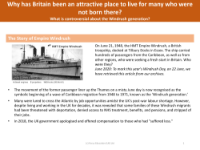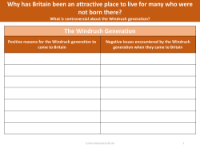What is controversial about the Windrush generation? - Presentation

Geography Resource Description
The Windrush generation refers to the Caribbean migrants who arrived in the UK between 1948 and 1971, starting with the passengers aboard the HMT Empire Windrush. The controversy surrounding this generation lies in the dichotomy between the British government's initial invitation to fill post-war job vacancies and the subsequent hostile reception and discrimination faced by these migrants. Despite the government's call for workers from the British Empire, the arrival of the Windrush passengers revealed underlying racial tensions. The migrants encountered a lack of welcome and acceptance, with many British people indifferent to their arrival. The controversy deepened as it was later discovered that some Windrush migrants and their families, who had lived and worked in the UK for decades, were wrongfully threatened with deportation and denied access to public services, leading to a government apology and compensation offers in 2018.
Britain's labour shortage after World War II, estimated at over one million, led to the recruitment of workers from various sources, including the Caribbean. However, discriminatory practices such as the "Whites Only" program for European Voluntary Workers (EVW) highlighted the racial prejudices of the time. Caribbean migrants, many of whom had served in the war effort, were British citizens and thus not subject to the same controls as EVWs. Despite the challenges, some Caribbean individuals encouraged others to move to the UK, hoping for a better future. A letter from Labour MPs to Prime Minister Clement Attlee in 1948 expressed concerns about the impact of 'coloured immigration' on British society, reflecting the era's racial attitudes. This sentiment persisted, with increased pressure from MPs when the Conservative Government took power in 1951, indicating the complex and often unwelcoming environment that the Windrush generation had to navigate upon their arrival in Britain.




